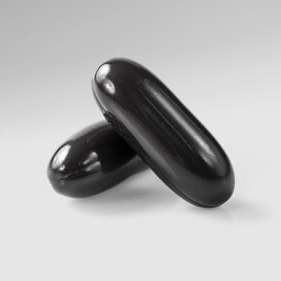BACKGROUND
Ingredient Type: Botanical
Also Known As: Laminaria digitate, Brown algae, Brown seaweed, Sea kelp

Kelp is a type of brown algae that grows in forests along the ocean floor. It is a significant source of iodine and has been used in traditional medicine practices to treat hypothyroidism.
Kelp has been consumed by various cultures around the world for centuries, especially in eastern Asia and the Pacific islands. The ancient Chinese used kelp medicinally to treat goiters (enlarged thyroid), while other Asian cultures utilized it for fertilizer. Kelp was harvested on a mass scale and burned during the 1700s to create soda ash, which was an essential component in glass production. This practice ended when mineral substitutes for soda ash were discovered. After that time, kelp continued to be harvested, but it was done so mainly for table salt and iodine. During World War I, the United States also harvested kelp for the production of acetone for smokeless gunpowder (1).
TRADITIONAL USES
A lack of dietary iodine results in a condition known as “hypothyroidism”, which is often associated with an enlargement of the thyroid known as “goiter.” The ancient Chinese began the practice of treating goiter with kelp thousands of years ago, recognizing that kelp generally aided or completely cured a swollen thyroid gland (2). They did not, however, recognize that iodine was the active compound responsible for this cure. The use of isolated iodine as a cure for hypothyroidism began in 1830 when the link between thyroid function and this element was first discovered (2).
WHAT DOES SCIENCE TELL US?
Kelp Promotes Thyroid Function In People With Iodine-Deficiency:
It has been known for centuries that kelp contains iodine (2). Kelp is, in fact, the greatest-known living accumulator of the element (3). The human thyroid requires iodine for the synthesis of certain thyroid hormones (4). It is widely recognized that the iodine in kelp can boost the production of these hormones in people suffering from iodine-deficient hypothyroidism.
It should be noted that iodine deficiency is relatively rare in the United States due to the voluntary iodization of salt. People who do not consume iodized salt, however, may be at higher risk of iodine deficiency (5).
Kelp Possibly Helps Lower Body Weight:
Kelp contains an active ingredient, fucoxanthin, that has been shown to promote the burning of excess fat in some animal studies. It is theorized that fucoxanthin supplementation causes an increase in resting energy expenditure, but further testing is necessary to ensure any effects in human subjects (6).
SAFETY
Interactions:
Major
- Antithyroid drugs
Moderate
- Lithium
- Amiodarone
Side-Effects:
Thyrotoxicosis induced by excess kelp consumption has been observed in some studies. Two patients, one who drank kelp tea for four weeks and another who was using iodine supplements, were the subjects of studies on thyrotoxicosis induced by kelp intake (7,8). Another 45-year-old woman was diagnosed with hypothyroidism and thyrotoxicosis after a two-month marketed diet containing a daily dose of 1800 µg of iodine (9).
Additionally, studies conducted in China, Denmark, and New Zealand have indicated that iodine supplement tablets of 400 µg, such as those made with kelp, can cause hypothyroidism due to an excess of iodine (10,11,12). Additionally, iodine supplementation in Spain and Zimbabwe resulted in higher numbers of reported thyrotoxicosis, though the supplementation in those cases was not derived from kelp (10,13,14). There are studies that suggest that long-term iodine supplementation over the period of decades can increase the risk of thyroid cancer, though these studies observed salt iodization as opposed supplements created with kelp (15,16). Patients taking the medication levothyroxine should not consume kelp, and kelp products should be avoided by those suffering from certain thyroid disorders (17).
The intake of excessive maternal multivitamins with iodine can cause congenital hypothyroidism. Immature, neonatal thyroids are especially susceptible to excess iodine which moves easily across the placenta (18).
REFERENCES
- Algae | Facts, Classification, & Examples – Ecological and commercial importance. Encyclopedia Britannica. https://www.britannica.com/science/algae/Ecological-and-commercial-importance. Accessed February 11, 2018.
- Niazi AK, Kalra S, Irfan A, Islam A. Thyroidology over the ages. Indian J Endocrinol Metab. 2011;15(Suppl2):S121-S126. doi:10.4103/2230-8210.83347
- Küpper FC, Carpenter LJ, McFiggans GB, et al. Iodide accumulation provides kelp with an inorganic antioxidant impacting atmospheric chemistry. PNAS. 2008;105(19):6954-6958. doi:10.1073/pnas.0709959105
- Takeuchi T, Kamasaki H, Hotsubo T, Tsutsumi H. Treatment of Hypothyroidism due to Iodine Deficiency Using Daily Powdered Kelp in Patients Receiving Long-term Total Enteral Nutrition. Clin Pediatr Endocrinol. 2011;20(3):51-55. doi:10.1297/cpe.20.51
- Iodine – fact sheet for consumers. National Institutes of Health Office of Dietary Supplements. Updated March 2, 2018. https://ods.od.nih.gov/factsheets/Iodine-HealthProfessional%20/. Accessed June 20, 2018.
- Jeukendrup AE, Randell R. Fat burners: nutrition supplements that increase fat metabolism. Obesity Reviews. 2011;12(10):841-851. doi:10.1111/j.1467-789X.2011.00908.x
- Eliason BC. Transient hyperthyroidism in a patient taking dietary supplements containing kelp. J Am Board Fam Pract. 1998;11(6):478-480.
- Müssig K, Thamer C, Bares R, Lipp H-P, Häring H-U, Gallwitz B. Iodine-Induced Thyrotoxicosis After Ingestion of Kelp-Containing Tea. J Gen Intern Med. 2006;21(6):C11-C14. doi:10.1111/j.1525-1497.2006.00416.x
- Di Matola T, Zeppa P, Gasperi M, Vitale M. Thyroid dysfunction following a kelp-containing marketed diet. BMJ Case Rep. 2014;2014. doi:10.1136/bcr-2014-206330
- Leung AM, Braverman LE. Consequences of excess iodine. Nat Rev Endocrinol. 2014;10(3):136-142. doi:10.1038/nrendo.2013.251
- Sang Z, Wang PP, Yao Z, et al. Exploration of the safe upper level of iodine intake in euthyroid Chinese adults: a randomized double-blind trial. Am J Clin Nutr. 2012;95(2):367-373. doi:10.3945/ajcn.111.028001
- Laurberg P, Jørgensen T, Perrild H, et al. The Danish investigation on iodine intake and thyroid disease, DanThyr: status and perspectives. Eur J Endocrinol. 2006;155(2):219-228. doi:doi:10.1530/eje.1.02210
- Galofré JC, Fernández-Calvet L, Ríos M, García-Mayor RV. Increased incidence of thyrotoxicosis after iodine supplementation in an iodine sufficient area. J Endocrinol Invest. 1994;17(1):23-27. doi:10.1007/BF03344958
- Todd CH, Allain T, Gomo ZA, Hasler JA, Ndiweni M, Oken E. Increase in thyrotoxicosis associated with iodine supplements in Zimbabwe. Lancet. 1995;346(8989):1563-1564.
- Dong W, Zhang H, Zhang P, et al. The changing incidence of thyroid carcinoma in Shenyang, China before and after universal salt iodization. Med Sci Monit. 2013;19:49-53.
- Blomberg M, Feldt-Rasmussen U, Andersen KK, Kjaer SK. Thyroid cancer in Denmark 1943-2008, before and after iodine supplementation. Int J Cancer. 2012;131(10):2360-2366. doi:10.1002/ijc.27497
- Can patients on levothyroxine take sea kelp? – SPS – Specialist Pharmacy Service. https://www.sps.nhs.uk/articles/can-patients-on-levothyroxine-take-sea-kelp/. Accessed February 22, 2018.
- Connelly KJ, Boston BA, Pearce EN, et al. Congenital Hypothyroidism Caused by Excess Prenatal Maternal Iodine Ingestion. J Pediatr. 2012;161(4):760-762. doi:10.1016/j.jpeds.2012.05.057
See the WebMD entry for laminaria or the RXList entry for laminaria for more information.









